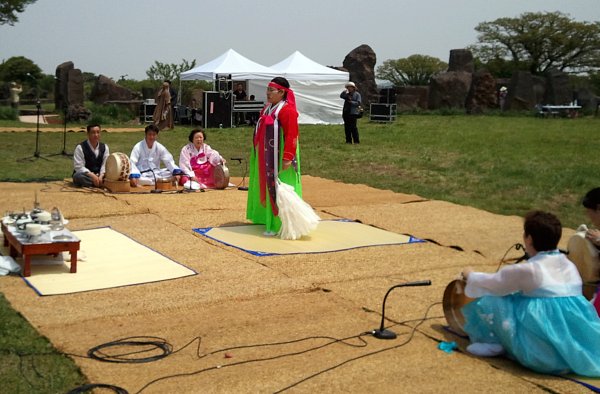
- Updated 2024.4.24 17:16
- All Articles
-
member
icon
-
facebook
cursor
-
twitter
cursor
|
Art&CultureEvents |
Honoring Jeju's grandmother creator goddessScenes from the Seolmundae Halmang Festival |
|
| |
 |
|
| ▲ Nine Priestesses, including a foreigner for the first time (the author). Photo by Joo Kang Hyun |
Seolmundae Halmang is grandmother to us all.
The central focus of Jeju's unique creation myth is a giant grandmother goddess. The personification of Mt. Halla, the volcano which by eruption created this island, She has nearly 400 offspring in the form of oreum (volcanic cones).
It has been said for some years now that Grandmother Seolmundae is sleeping.
Public rituals in her name were regularly performed throughout Jeju's history, though they were suppressed during the Japanese occupation and had ceased entirely by 1950 during the turmoil that led to Korea's civil war.
No one can say whether private rituals have continued. Surely the people of Jeju speak of Her fondly and in many cases, reverently.
A public festival, a term which in Jeju often refers to a series of shamanic rituals, was created in 2004 to honor this grandmother goddess, and has been held annually since that time.
The event always takes place on the 15th of May, though the location changes from year to year. This year and for the second time, it was held at the Jeju Stone Park.
| |
 |
|
| ▲ Shaman Lee Young-ok. Photo by Anne Hilty |
The Seolmundae Halmang festival consists of two parts. The morning is dominated by a series of “gut” or shamanic rites, while the afternoon's event is a scholarly conference.
The first ritual, or “ap-gut,” is a preliminary rite to prepare the ritual space. It involves drumming, singing, and dancing, all in traditional form. Thus, the stage is set.
The main ritual, or “bon gut,” consists of nine stages. The first seven are facilitated by nine “je gwan” or “priestesses” who are women of the community. In the eighth stage, true to Korea's syncretic approach to religion, leaders from non-shamanic religious traditions also invoke and ask for the blessings of Seolmundae Halmang.
The ninth and final stage of the “bon gut” is the centerpiece, the Seolmundae Halmang Gut performed by a society of shamans. Following this, traditional performers provide the “dwit gut” or closing ceremony.
The acclaimed Jeju-born actress Ko Du Sim who, in honor of her roots, participates regularly in Jeju's cultural events, was the lead priestess in this year's ritual. For the first time, the ritual included a foreign “je gwan”: this writer.
The honor of participating with eight Jeju women in such a traditional and reverent event was deeply moving.
The series of rites included an invocation to the grandmother goddess, supplication in the form of bows, and offerings of camellia branches in bloom and sheaths of barley, placed on the altar and later tossed into nearby ponds to entreat Her blessing.
Participating in the ecumenical invocations were a Catholic priest and monks from two Buddhist sects. Following this, shamans of the Chilmeoridang Yeongdeung-gut Preservation Society performed a full multi-phase ritual to Seolmundae Halmang. Shaman or “simbang” Lee Young-ok facilitated.
Noripae Hallasan, a theatre group in existence since 1987 and with a focus on social issues, performed the closing ritual in the form of a traditional mask dance.
Following a lunch of “gogi guksu,” Jeju's traditional pork and noodle soup, washed down with Jeju makgeolli, or fermented rice wine, the academic seminar commenced.
The seminar had two sessions for a total of five presenting scholars and five discussants. The first session began with a presentation on the general characteristics and patterns of goddesses by Kwan Tae-hyo of the National Folk Museum.
Kim Heon-seon of Gyeonggi University then presented on the principles of East Asian women's myths, while Jo Hyeon-seol of Seoul National University followed with the meaning of Jeju's goddess mythology.
In the final session, Lee Chang-sik of Semyung University spoke on storytelling and globalization and was followed by Heo Nam-chun of Jeju National University who focused on the meaning of and change in this creation goddess mythology.
A period of open discussion followed the second session, and the day's tribute to Seolmundae Halmang, grandmother creator goddess to all, was complete – until next year.
Dr. Hilty is a cultural health psychologist. |
|
|
|
|
|
|
|
ⓒ Jeju Weekly 2009 (http://www.jejuweekly.net)
All materials on this site are protected under the Korean Copyright Law and may not be reproduced, distributed, transmitted, displayed, published without the prior consent of Jeju Weekly. |
|
|
|
|
| Jeju-Asia's No.1 for Cruise |
|
|
|
Title:The jeju Weekly(제주위클리) | Mail to editor@jejuweekly.net | Phone: +82-64-724-7776 Fax: +82-64-724-7796
#503, 36-1, Seogwang-ro, Jeju-si, Jeju-do, Korea, 63148
Registration Number: Jeju, Ah01158(제주,아01158) | Date of Registration: November 10,2022 | Publisher&Editor : Hee Tak Ko | Youth policy: Hee Tak Ko
Copyright ⓒ 2009 All materials on this site are protected under the Korean Copyright Law and may not be reproduced, distributed, transmitted, displayed, published
without the prior consent of jeju weekly.com.

|





















